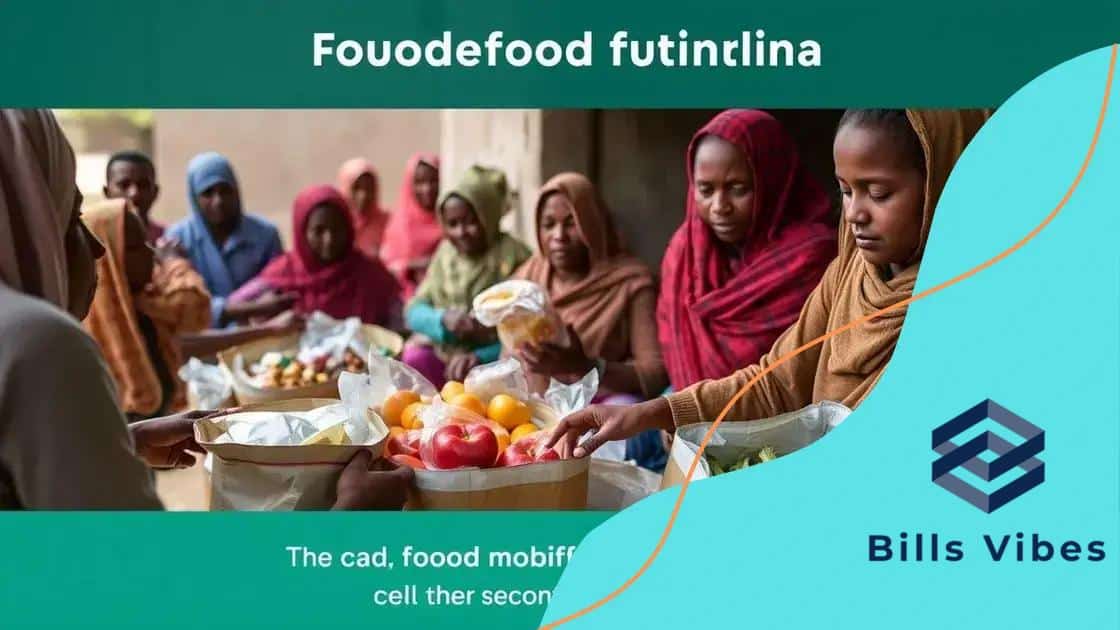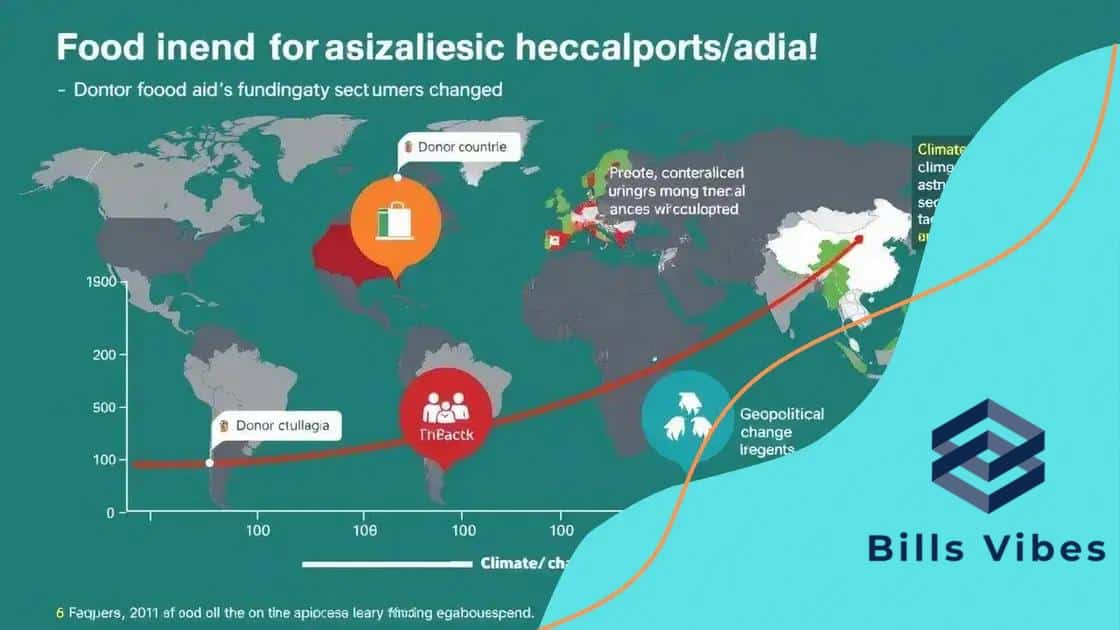Food aid funding shifts occur as resources change

Food aid funding shifts occur due to changing donor priorities, economic conditions, and global crises, impacting the delivery and effectiveness of food security initiatives worldwide.
Food aid funding shifts occur frequently, reflecting the changing global landscape. Have you ever wondered how these shifts impact the communities that rely on assistance? Let’s delve into the dynamics of these vital resources.
Understanding food aid funding dynamics
Understanding food aid funding dynamics is essential for grasping how resources evolve to meet global needs. These dynamics play a pivotal role in addressing hunger and providing support to vulnerable populations.
Several factors influence the flow of food aid funding. Economic conditions, donor priorities, and changing political climates all play significant roles. As these elements shift, the availability and distribution of resources can drastically alter.
Key Influences on Food Aid Funding
One of the main influences is the global economic climate. When economies are in turmoil, governments may reduce their funding commitments. This can lead to a decrease in the aid available for countries suffering from food insecurity.
Donor Priorities
Donor priorities also heavily influence funding. Some donors may shift their focus towards specific regions or crisis situations. This can create disparities in aid distribution, as some areas receive enhanced support while others are overlooked.
- Changes in government leadership can redirect funding.
- The rise of emerging economies can shift donor priorities.
- Increased attention to climate change impacts food aid strategies.
Moreover, international organizations play a crucial role in coordinating aid strategies. Their assessments help streamline funding efforts to where they are most needed, which is essential in areas facing severe drought or conflict.
As we evaluate these funding dynamics, it’s important to recognize the impact on local communities. Access to aid can significantly affect food availability and health outcomes.
With ongoing global challenges such as climate change and conflict, the understanding of food aid funding dynamics will be vital for ensuring that resources effectively reach those in need.
Key players in food aid funding
Key players in food aid funding include governments, international organizations, and non-governmental organizations (NGOs). Each of these entities plays a crucial role in shaping how and where aid is distributed.
Governments are often the largest donors. They allocate funds based on national priorities, which can vary widely between countries. For example, a country dealing with internal crises may increase its own food aid, while another may focus on international assistance.
International Organizations
International organizations like the United Nations (UN) and the World Food Program (WFP) act as coordinators in food aid distribution. They assess needs and allocate resources accordingly, ensuring that food reaches those who need it most.
Non-Governmental Organizations
NGOs also play a vital role. They often operate on the ground, directly interacting with affected communities. NGOs can mobilize quickly to respond to crises, providing immediate assistance.
- Many NGOs have specialized programs targeting malnutrition.
- They often leverage local partnerships to enhance aid effectiveness.
- Grassroots initiatives can emerge from these organizations, ensuring community needs are met.
The collaboration among these key players is essential for effective aid delivery. By working together, they can address the complexities of food insecurity more efficiently.
Understanding the dynamics of these actors helps clarify how funding moves from donors to communities in need. This knowledge is critical for improving strategies and outcomes in food assistance.
Recent shifts in funding allocations

Recent shifts in funding allocations for food aid programs have significant implications. These changes often reflect broader economic and social trends, impacting how resources are distributed across various regions.
One key factor driving these shifts is the changing priorities of donor countries. In recent years, many nations have adjusted their budgets in response to domestic challenges, which can lead to reductions in overall food aid. Such decisions can directly affect programs aimed at combating hunger in vulnerable populations.
Geopolitical Influence
Geopolitical events also play a crucial role in funding allocations. Conflicts and natural disasters can divert resources to immediate needs, causing shifts in funding away from established programs. For example, natural disasters might prompt a surge in funding for emergency food relief, while longer-term development initiatives may receive less attention.
Emerging Needs
Another important aspect is the recognition of emerging needs, such as the impacts of climate change. As conditions evolve, funding sources may adjust in priority to meet the rising challenges of food security related to environmental factors.
- Increased focus on sustainable agriculture and climate resilience.
- Growin interest in addressing malnutrition alongside hunger.
- Shifts toward funding localized solutions to enhance effectiveness.
The interplay of these factors highlights the dynamic nature of food aid funding. By being aware of these shifts, stakeholders can better strategize and respond to the evolving landscape of global food assistance.
Impact of funding shifts on hunger solutions
The impact of funding shifts on hunger solutions is significant and multifaceted. Changes in how funds are allocated can directly affect the effectiveness of programs designed to combat food insecurity.
When funds are reallocated, some regions may experience reduced resources. This can lead to disrupted food assistance programs, affecting countless households. Additionally, a sudden lack of funding can hinder the implementation of long-term agricultural projects that are essential for sustainable food security.
Immediate Effects on Food Assistance
In the short term, funding shifts often result in immediate consequences for food aid distribution. For example, if a donor decides to focus on emergency relief rather than development aid, communities that rely on ongoing support may suffer.
Sustainable Solutions at Risk
Moreover, these shifts can jeopardize initiatives aimed at fostering self-sufficiency. Programs that support local farmers, promote sustainable practices, and encourage community involvement are essential for maintaining food security. Without consistent funding, these initiatives can falter, leaving communities vulnerable.
- Increased reliance on food banks and emergency supplies.
- Difficulty in accessing nutritional education programs.
- Higher rates of malnutrition and food scarcity.
The long-term consequences of funding shifts can also perpetuate cycles of poverty. When communities lack stable food sources, it becomes challenging to break free from the issues of hunger and malnutrition.Food security is intrinsically linked to economic stability and health; thus, any disruption can have lasting effects.
Understanding the impact of these shifts can lead to more informed decisions by stakeholders. It is crucial for donors and organizations to consider how their funding choices influence hunger solutions at both local and global levels.
Future trends in food aid funding
Future trends in food aid funding are set to evolve in response to changing global challenges. As the world faces increased food insecurity, understanding these trends is essential.
One prominent trend is the shift towards more sustainable funding models. Donors are becoming more interested in long-term solutions that promote self-sufficiency rather than just immediate relief. This means investing in local agriculture and education to ensure communities can withstand future crises.
Increased Focus on Climate Change
Climate change is another major factor influencing funding strategies. As environmental challenges affect food production, funding will increasingly aim to support adaptation strategies. These include promoting drought-resistant crops and supporting farmers with innovative techniques to cope with changing weather patterns.
Collaboration with Private Sector
There is also a growing trend toward collaboration with the private sector. Partnerships between NGOs and businesses can lead to innovative solutions and increased resources for food aid programs. By leveraging private sector expertise and funding, organizations can drive impactful projects.
- Utilizing technology to improve food distribution.
- Encouraging corporate social responsibility initiatives focused on hunger.
- Implementing public-private partnerships for more effective results.
Moreover, the use of data-driven approaches in decision-making is gaining traction. By analyzing trends and outcomes, donors can tailor their funding more effectively to meet the needs of communities facing food insecurity.
As these future trends develop, it will be vital to adapt and respond to the changing landscape of food aid funding. Stakeholders must remain flexible and innovative to address the ongoing challenges of hunger and malnutrition across the globe.
In conclusion, understanding the landscape of food aid funding is crucial for effectively addressing hunger and food insecurity worldwide. As funding dynamics shift, the focus is increasingly on sustainable solutions, partnerships, and innovative strategies. By recognizing the key players and their influence, as well as the emerging trends, stakeholders can better respond to the challenges at hand. Ensuring that food aid is adaptable and responsive will be essential for supporting vulnerable communities now and in the future.
\n
\n
FAQ – Frequently Asked Questions about Food Aid Funding
What are the main challenges in food aid funding?
The main challenges include fluctuating donor priorities, shifting economic conditions, and the impact of global crises such as climate change and conflicts.
How can sustainable practices improve food security?
Sustainable practices enhance food security by promoting self-sufficiency, supporting local agriculture, and ensuring that communities are resilient to future challenges.
What role do partnerships play in food aid?
Partnerships between NGOs and the private sector can lead to innovative solutions, increased resources, and more impactful food aid programs.
Why is data important for food aid funding?
Data helps organizations analyze trends, assess needs, and make informed funding decisions that improve the effectiveness of food aid initiatives.






